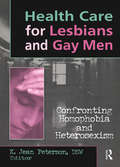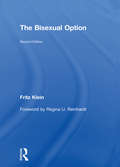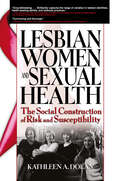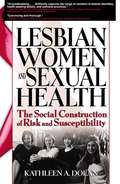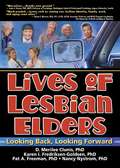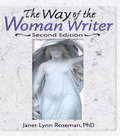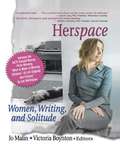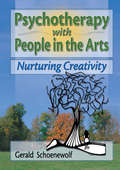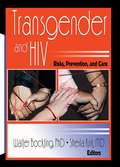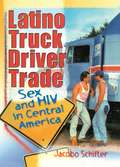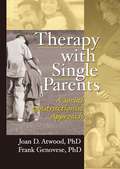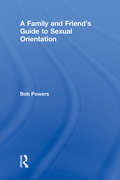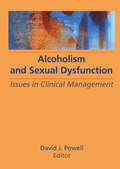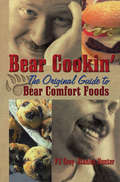- Table View
- List View
Health Care for Lesbians and Gay Men: Confronting Homophobia and Heterosexism
by K Jean PetersonHealth Care for Lesbians and Gay Men educates practitioners about the special needs of gay and lesbian patients and how to look critically at the impact of homophobia and heterosexism on the provision of care. It provides an overview of critical health care issues for lesbians and gay men and offers concrete suggestions to health practitioners and social workers on how to address these issues in order to guarantee the best care for their patients and clients. Authors in Health Care for Lesbians and Gay Men give health care providers and mental health workers practical interventions; suggestions for advocacy, social change, grassroots efforts, and alternative programs; and lessons about how to use existing procedures to more effectively meet the unique health care needs of gays and lesbians. Practitioners also learn how to utilize legal action in securing and protecting patients’and clients’personal health care wishes. Chapters in this book cover: how homophobia and negative attitudes can directly compromise the care given to lesbians and gay men. heterosexism and biases which exclude the partners of gay men and lesbians from participating in the care of their loved ones. legal issues and the need for legal recognition of gay and lesbian relationships, both to enhance the provision of care and for financial access to health care presently available to only heterosexual, married couples. legal protection and special legal documents that ensure that the wishes of gay men and lesbians are honored and the integrity of their relationships not violated.Health Care for Lesbians and Gay Men starts with special issues confronting adolescents and the special role health care providers can play in supporting the struggles of lesbian and gay adolescents. It then continues to look at these issues over the life cycle. Three themes emerge as authors try to explain problems and possible solutions for lesbians and gay men seeking health care: the pervasive homophobia and heterosexism found throughout the health care system and the impact these attitudes and beliefs have on the health care of lesbians and gay men; the need for education in professional programs on special health issues of gay men and lesbians; and the critical role that social workers can play in both educating others about the special needs of their gay and lesbian clients and in advocating for their clients in various health care settings.Health Care for Lesbians and Gay Men is essential reading for social work and social service practitioners and students working in the health care field, advanced undergraduates and graduate students of social work, professionals and students of nursing and medicine, and others concerned with the quality and equality of health care services. It urges students and professionals to challenge and evaluate their own attitudes, beliefs, and behaviors in order to ensure quality services to all clients and patients.
Health Care for Lesbians and Gay Men: Confronting Homophobia and Heterosexism
by K Jean PetersonHealth Care for Lesbians and Gay Men educates practitioners about the special needs of gay and lesbian patients and how to look critically at the impact of homophobia and heterosexism on the provision of care. It provides an overview of critical health care issues for lesbians and gay men and offers concrete suggestions to health practitioners and social workers on how to address these issues in order to guarantee the best care for their patients and clients. Authors in Health Care for Lesbians and Gay Men give health care providers and mental health workers practical interventions; suggestions for advocacy, social change, grassroots efforts, and alternative programs; and lessons about how to use existing procedures to more effectively meet the unique health care needs of gays and lesbians. Practitioners also learn how to utilize legal action in securing and protecting patients’and clients’personal health care wishes. Chapters in this book cover: how homophobia and negative attitudes can directly compromise the care given to lesbians and gay men. heterosexism and biases which exclude the partners of gay men and lesbians from participating in the care of their loved ones. legal issues and the need for legal recognition of gay and lesbian relationships, both to enhance the provision of care and for financial access to health care presently available to only heterosexual, married couples. legal protection and special legal documents that ensure that the wishes of gay men and lesbians are honored and the integrity of their relationships not violated.Health Care for Lesbians and Gay Men starts with special issues confronting adolescents and the special role health care providers can play in supporting the struggles of lesbian and gay adolescents. It then continues to look at these issues over the life cycle. Three themes emerge as authors try to explain problems and possible solutions for lesbians and gay men seeking health care: the pervasive homophobia and heterosexism found throughout the health care system and the impact these attitudes and beliefs have on the health care of lesbians and gay men; the need for education in professional programs on special health issues of gay men and lesbians; and the critical role that social workers can play in both educating others about the special needs of their gay and lesbian clients and in advocating for their clients in various health care settings.Health Care for Lesbians and Gay Men is essential reading for social work and social service practitioners and students working in the health care field, advanced undergraduates and graduate students of social work, professionals and students of nursing and medicine, and others concerned with the quality and equality of health care services. It urges students and professionals to challenge and evaluate their own attitudes, beliefs, and behaviors in order to ensure quality services to all clients and patients.
The Bisexual Option: Second Edition
by Fritz KleinSoon to be translated into Japanese! The Bisexual Option explores bisexuality, explains the bisexual, and explodes myths surrounding this large “unseen” segment of the population. Now in its second edition, this intriguing book gives an overview of bisexuality. As there is still no book that covers the subject like this one, it is must reading for establishing a contemporary view of bisexuality and those committed to a bisexual lifestyle. Fritz Klein, an experienced psychiatrist and expert in bisexuality and sexual orientation, explains the concept and the variables of sexual orientation and where bisexuality fits.He covers many subjects in the book including: myths of bisexual nonexistence and the “either/or” dilemma intimacy, both emotional and sexual an explanation of bisexuality and the Oedipus Complex definitions and examples of the healthy and troubled bisexual major sociological findings about bisexuality the bisexual in history the bisexual as depicted in the arts factors that will influence bisexuality in the futureThe book helps readers understand where they fit on the sexual orientation continuum. The Bisexual Option aids in explaining who bisexuals are and why they have problems in heterosexual as well as homosexual societies and shows bisexuals that they are not alone. Even helping professionals will find information on this “invisible” but large segment of the population.A variety of readers will want to read The Bisexual Option including the bisexual community and individual bisexuals, the homosexual communities which include many bisexuals, mental health practitioners, psychologists, both students and professionals, university students, married partners of bisexuals, HIV/AIDS workers who wish to become acquainted with how bisexuality affects the risk to the heterosexual community, sexologists, and researchers.
The Bisexual Option: Second Edition
by Fritz KleinSoon to be translated into Japanese! The Bisexual Option explores bisexuality, explains the bisexual, and explodes myths surrounding this large “unseen” segment of the population. Now in its second edition, this intriguing book gives an overview of bisexuality. As there is still no book that covers the subject like this one, it is must reading for establishing a contemporary view of bisexuality and those committed to a bisexual lifestyle. Fritz Klein, an experienced psychiatrist and expert in bisexuality and sexual orientation, explains the concept and the variables of sexual orientation and where bisexuality fits.He covers many subjects in the book including: myths of bisexual nonexistence and the “either/or” dilemma intimacy, both emotional and sexual an explanation of bisexuality and the Oedipus Complex definitions and examples of the healthy and troubled bisexual major sociological findings about bisexuality the bisexual in history the bisexual as depicted in the arts factors that will influence bisexuality in the futureThe book helps readers understand where they fit on the sexual orientation continuum. The Bisexual Option aids in explaining who bisexuals are and why they have problems in heterosexual as well as homosexual societies and shows bisexuals that they are not alone. Even helping professionals will find information on this “invisible” but large segment of the population.A variety of readers will want to read The Bisexual Option including the bisexual community and individual bisexuals, the homosexual communities which include many bisexuals, mental health practitioners, psychologists, both students and professionals, university students, married partners of bisexuals, HIV/AIDS workers who wish to become acquainted with how bisexuality affects the risk to the heterosexual community, sexologists, and researchers.
Lesbian Women and Sexual Health: The Social Construction of Risk and Susceptibility
by R Dennis Shelby Kathleen DolanInterviewer: Where did you find out how to have safe lesbian sex?Val: I found out in jail.Why do so many lesbian women engage in sexual behavior that puts their health, even their lives, at risk? Many know they&’re at risk, yet somehow feel safe enough to behave as if there is no reason to practice safe sex. Lesbian Women and Sexual Health: The Social Construction of Risk and Susceptibility examines how lesbian women perceive their level of risk for HIV and other sexually transmitted infections (STIs). It describes how their perceptions of risk and susceptibility are shaped by factors such as sexual identity, cultural themes, and community knowledge-and how those perceptions impact on the very real HIV/STI risks that lesbian women face. The genesis of Lesbian Women and Sexual Health: The Social Construction of Risk and Susceptibility lies in Kathleen Dolan&’s exploratory study of this under-researched area, in which 162 structured interviews and 70 in-depth interviews were conducted with women who self-identify as lesbians. What these women have to say will inform, educate, and probably surprise you. Tables and figures make complex data easy to access and understand.Lesbian women construct and label their identities and actions in complex ways that may lead to risky behavior. In the words of the women surveyed-and in Dr. Dolan&’s insightful commentary-this book explores the ways in which lesbian women construct their perceptions of risk and susceptibility to seek answers to questions that include: Do many lesbian women see themselves, to an extent, as immune to HIV contraction? How does their self-constructed sense of risk and susceptibility lead to making dangerous choices? Why, in spite of their professed willingness to engage in protective actions, do many lesbians not actually do so? Why do many lesbian women, and some of the health care professionals who serve them, feel that pap smears are not necessary for women who have sex only with other women-and what are the consequences of this opinion? What is the relationship between drug/alcohol use and risky sexual behaviors in lesbian women?Lesbian Women and Sexual Health: The Social Construction of Risk and Susceptibility is an important resource for women&’s/lesbian health advocates, health care professionals, and courses in gay/women&’s/medical studies. It addresses gaps in the existing research to enhance our understanding of the physical and mental health status of lesbian women, of risk factors and protective actions regarding HIV and STIs, and of the conditions for which protective actions actually reduce risk. Use it to update your knowledge of this under-studied area at the intersection of physical, emotional, and sexual health.
Lesbian Women and Sexual Health: The Social Construction of Risk and Susceptibility
by R Dennis Shelby Kathleen DolanInterviewer: Where did you find out how to have safe lesbian sex?Val: I found out in jail.Why do so many lesbian women engage in sexual behavior that puts their health, even their lives, at risk? Many know they&’re at risk, yet somehow feel safe enough to behave as if there is no reason to practice safe sex. Lesbian Women and Sexual Health: The Social Construction of Risk and Susceptibility examines how lesbian women perceive their level of risk for HIV and other sexually transmitted infections (STIs). It describes how their perceptions of risk and susceptibility are shaped by factors such as sexual identity, cultural themes, and community knowledge-and how those perceptions impact on the very real HIV/STI risks that lesbian women face. The genesis of Lesbian Women and Sexual Health: The Social Construction of Risk and Susceptibility lies in Kathleen Dolan&’s exploratory study of this under-researched area, in which 162 structured interviews and 70 in-depth interviews were conducted with women who self-identify as lesbians. What these women have to say will inform, educate, and probably surprise you. Tables and figures make complex data easy to access and understand.Lesbian women construct and label their identities and actions in complex ways that may lead to risky behavior. In the words of the women surveyed-and in Dr. Dolan&’s insightful commentary-this book explores the ways in which lesbian women construct their perceptions of risk and susceptibility to seek answers to questions that include: Do many lesbian women see themselves, to an extent, as immune to HIV contraction? How does their self-constructed sense of risk and susceptibility lead to making dangerous choices? Why, in spite of their professed willingness to engage in protective actions, do many lesbians not actually do so? Why do many lesbian women, and some of the health care professionals who serve them, feel that pap smears are not necessary for women who have sex only with other women-and what are the consequences of this opinion? What is the relationship between drug/alcohol use and risky sexual behaviors in lesbian women?Lesbian Women and Sexual Health: The Social Construction of Risk and Susceptibility is an important resource for women&’s/lesbian health advocates, health care professionals, and courses in gay/women&’s/medical studies. It addresses gaps in the existing research to enhance our understanding of the physical and mental health status of lesbian women, of risk factors and protective actions regarding HIV and STIs, and of the conditions for which protective actions actually reduce risk. Use it to update your knowledge of this under-studied area at the intersection of physical, emotional, and sexual health.
Lives of Lesbian Elders: Looking Back, Looking Forward
by J Dianne Garner D. Merilee Clunis Pat A. Freeman Nancy M. Nystrom Karen I. Fredriksen-GoldsenThe untold history of lesbian life from those who have lived it! Lives of Lesbian Elders: Looking Back, Looking Forward illuminates the hopes, fears, issues, and concerns of gay women as they grow older. Based on interviews with 62 lesbians ranging in age from 55 to 95, this very special book provides a historical account of the shared experiences of the lesbian community that is so often invisible or ignored in contemporary society. The book gives voice to their thoughts and feelings on a wide range of issues, including coming out, identity and the meaning of life, the role of family and personal relationships, work and retirement, adversity, and individual sources of strength and resilience. Cast off and overlooked at best or victims of scorn and prejudice at worst, lesbians in the twentieth century lived dual lives, their full voices unheard-until now. Lives of Lesbian Elders chronicles the life choices they made and their reasons for making them, set against the contexts of culture, politics, and the social mores of the eras in which they lived. Their stories of courage, resilience, resourcefulness, pride, and independence help restore lesbian history that has been forgotten, distorted, or disregarded and provide the information necessary to meet the future needs of aging lesbians. Lives of Lesbian Elders gives aging lesbians a chance to discuss their thoughts on a variety of topics, including: Coming out "You didn&’t talk about it . . . Until two years ago, I never even referred to a lesbian or would I allow the word to pass my lips" "I used to sneak into libraries and read about homosexuality and back in that era, it was not classy . . . it was classified as a disorder of some type" Identity "The only difference between me and anybody else is that I just happen to be sleeping with a woman" "I think I grew up not really knowing who I was and, I think, probably fighting all my life trying to find out who I was" Family "I feel very connected with the lesbian community here . . . I guess I would call that family" "Many years ago, my sister said: &’I think when they&’re ready, you need to explain to (the nieces) what a lesbian is, because I want them to hear the correct story . . . I want them to hear what it really is and not all these stupid rumors that go around&’" Work "I was going to become a youth minister at one point and it dawned on me in high school that there was no way the church was going to let me work with kids" "I didn&’t really finish my career . . . I still have dreams about the military and about not finishing . . . It was my choice, but it wasn&’t really my choice" Aging and the Future "I think financing, of course, is a real big problem for lesbian women" "I have a concern that if anything should happen to my partner-in growing older-of being isolated from the gay community" . . . and much more! Lives of Lesbian Elders: Looking Back, Looking Forward also includes appendices that present demographic data on the women who were interviewed for the book, information on historical timelines, and suggested readings on lesbian history. The book is an invaluable addition to the growing collective history of lesbians in the United States.
Lives of Lesbian Elders: Looking Back, Looking Forward
by J Dianne Garner D. Merilee Clunis Pat A. Freeman Nancy M. Nystrom Karen I. Fredriksen-GoldsenThe untold history of lesbian life from those who have lived it! Lives of Lesbian Elders: Looking Back, Looking Forward illuminates the hopes, fears, issues, and concerns of gay women as they grow older. Based on interviews with 62 lesbians ranging in age from 55 to 95, this very special book provides a historical account of the shared experiences of the lesbian community that is so often invisible or ignored in contemporary society. The book gives voice to their thoughts and feelings on a wide range of issues, including coming out, identity and the meaning of life, the role of family and personal relationships, work and retirement, adversity, and individual sources of strength and resilience. Cast off and overlooked at best or victims of scorn and prejudice at worst, lesbians in the twentieth century lived dual lives, their full voices unheard-until now. Lives of Lesbian Elders chronicles the life choices they made and their reasons for making them, set against the contexts of culture, politics, and the social mores of the eras in which they lived. Their stories of courage, resilience, resourcefulness, pride, and independence help restore lesbian history that has been forgotten, distorted, or disregarded and provide the information necessary to meet the future needs of aging lesbians. Lives of Lesbian Elders gives aging lesbians a chance to discuss their thoughts on a variety of topics, including: Coming out "You didn&’t talk about it . . . Until two years ago, I never even referred to a lesbian or would I allow the word to pass my lips" "I used to sneak into libraries and read about homosexuality and back in that era, it was not classy . . . it was classified as a disorder of some type" Identity "The only difference between me and anybody else is that I just happen to be sleeping with a woman" "I think I grew up not really knowing who I was and, I think, probably fighting all my life trying to find out who I was" Family "I feel very connected with the lesbian community here . . . I guess I would call that family" "Many years ago, my sister said: &’I think when they&’re ready, you need to explain to (the nieces) what a lesbian is, because I want them to hear the correct story . . . I want them to hear what it really is and not all these stupid rumors that go around&’" Work "I was going to become a youth minister at one point and it dawned on me in high school that there was no way the church was going to let me work with kids" "I didn&’t really finish my career . . . I still have dreams about the military and about not finishing . . . It was my choice, but it wasn&’t really my choice" Aging and the Future "I think financing, of course, is a real big problem for lesbian women" "I have a concern that if anything should happen to my partner-in growing older-of being isolated from the gay community" . . . and much more! Lives of Lesbian Elders: Looking Back, Looking Forward also includes appendices that present demographic data on the women who were interviewed for the book, information on historical timelines, and suggested readings on lesbian history. The book is an invaluable addition to the growing collective history of lesbians in the United States.
The Way of the Woman Writer
by Janet Lynn RosemanThe Way of the Woman Writer, Second Edition continues the work of the inspirational original, offering guidance to women who wish to document their lives in writing. More a template than a how-to manual, this insightful book addresses the concerns, needs, and issues of women writers (both aspiring and experienced), concentrating on the internal process of putting thought to paper, including new chapters on the creative process and the ethics and integrity of writing. The author, Dr. Janet Lynn Roseman, offers writing exercises in women's autobiography that draw on the significant rhythms of a woman's life, utilizing visualization and meditation techniques to amplify the inner writing voice. From the author: "What strikes me in re-examining the text of this book is just how timeless the subject of chronicling women's lives is. When we pass down our stories and share them with family and friends, we provide future generations with the opportunity to not only understand the lives of each woman, but we are able to gain insight into their unique experiences." The Way of the Woman Writer, Second Edition includes new writing samples and new chapters on: "The Creative Spirit," which presents a seven-step guide to the creative process-ritual, surrender, silence, waiting, trust, recognition, and distance "The Ethics and Integrity of Writing," which addresses the discipline and courage a writer needs when dealing with the effects of her autobiographical "truths" on others The Way of the Woman Writer, Second Edition is an essential resource for creative writing courses, oral history courses, writer's workshops, and women's studies programs, and an invaluable guide for any woman who wishes to tell her story.
The Way of the Woman Writer
by Janet Lynn RosemanThe Way of the Woman Writer, Second Edition continues the work of the inspirational original, offering guidance to women who wish to document their lives in writing. More a template than a how-to manual, this insightful book addresses the concerns, needs, and issues of women writers (both aspiring and experienced), concentrating on the internal process of putting thought to paper, including new chapters on the creative process and the ethics and integrity of writing. The author, Dr. Janet Lynn Roseman, offers writing exercises in women's autobiography that draw on the significant rhythms of a woman's life, utilizing visualization and meditation techniques to amplify the inner writing voice. From the author: "What strikes me in re-examining the text of this book is just how timeless the subject of chronicling women's lives is. When we pass down our stories and share them with family and friends, we provide future generations with the opportunity to not only understand the lives of each woman, but we are able to gain insight into their unique experiences." The Way of the Woman Writer, Second Edition includes new writing samples and new chapters on: "The Creative Spirit," which presents a seven-step guide to the creative process-ritual, surrender, silence, waiting, trust, recognition, and distance "The Ethics and Integrity of Writing," which addresses the discipline and courage a writer needs when dealing with the effects of her autobiographical "truths" on others The Way of the Woman Writer, Second Edition is an essential resource for creative writing courses, oral history courses, writer's workshops, and women's studies programs, and an invaluable guide for any woman who wishes to tell her story.
Herspace: Women, Writing, and Solitude
by J Dianne Garner Victoria Boynton Jo MalinThis collection delves deeply into the power of solitude in a richly detailed exploration of the lives of women writers! The essays in this fascinating volume combine literary theory, autobiography, performance, and criticism, while opening minds and expanding concepts of women's roles both in the home and within academia along the way. Herspace: Women, Writing, and Solitude begins with a discussion of the importance of solitude to the works of a variety of writers, including Margaret Atwood, May Sarton, Virginia Woolf, Marguerite Duras, and Zora Neale Hurston, and then moves on to an examination of the actual solitary spaces of women writers. The book concludes with the stories of modern women asserting their right to a space of their own. These essays, full of pain and new growth, lessons learned and battles fought, resound with the honesty and courage the authors have found in the process of truly making their own homes. Herspace examines: the stereotyped spinster solitude as a process and a journey women's prison literature cars, empty nests, kitchen counters, and other found spaces for writing the meaning of a home of one's own creating beauty in solitary settings Contributors to Herspace have made a conscious effort to integrate the personal with the academic, and the result is a volume of surprising intimacy, a window into the world of women writers past and present actively engaging solitude. From finding and defining the muse to the identity issues of home ownership, Herspace, which includes Jan Wellington's essay "What to Make of Missing Children (A Life Slipping into Fiction)," (winner of the 2003 NCTE Donald Murray Prize for "the best creative essay about teaching and/or writing published during the preceding year") provides you with the perspectives of women who are living these issues. As the editors write: "The solitary space itself enables the writing process, protects it. And women, more than men, need this enabling protection. Women need to claim their own space, to bargain and plan and keep out of sight that solitary space in which to commune with their thoughts and feelings, to experience their creative process intimately." Herspace explores these women's experiences, revealing the unique creativity that comes from solitude.
Herspace: Women, Writing, and Solitude
by J Dianne Garner Victoria Boynton Jo MalinThis collection delves deeply into the power of solitude in a richly detailed exploration of the lives of women writers! The essays in this fascinating volume combine literary theory, autobiography, performance, and criticism, while opening minds and expanding concepts of women's roles both in the home and within academia along the way. Herspace: Women, Writing, and Solitude begins with a discussion of the importance of solitude to the works of a variety of writers, including Margaret Atwood, May Sarton, Virginia Woolf, Marguerite Duras, and Zora Neale Hurston, and then moves on to an examination of the actual solitary spaces of women writers. The book concludes with the stories of modern women asserting their right to a space of their own. These essays, full of pain and new growth, lessons learned and battles fought, resound with the honesty and courage the authors have found in the process of truly making their own homes. Herspace examines: the stereotyped spinster solitude as a process and a journey women's prison literature cars, empty nests, kitchen counters, and other found spaces for writing the meaning of a home of one's own creating beauty in solitary settings Contributors to Herspace have made a conscious effort to integrate the personal with the academic, and the result is a volume of surprising intimacy, a window into the world of women writers past and present actively engaging solitude. From finding and defining the muse to the identity issues of home ownership, Herspace, which includes Jan Wellington's essay "What to Make of Missing Children (A Life Slipping into Fiction)," (winner of the 2003 NCTE Donald Murray Prize for "the best creative essay about teaching and/or writing published during the preceding year") provides you with the perspectives of women who are living these issues. As the editors write: "The solitary space itself enables the writing process, protects it. And women, more than men, need this enabling protection. Women need to claim their own space, to bargain and plan and keep out of sight that solitary space in which to commune with their thoughts and feelings, to experience their creative process intimately." Herspace explores these women's experiences, revealing the unique creativity that comes from solitude.
Psychotherapy with People in the Arts: Nurturing Creativity
by Terry S Trepper Gerald SchoenewolfLearn to free creativity from the shackles of emotional conflicts!This riveting collection of case histories illustrates the dark interplay of neurosis and creativity. Psychotherapy with People in the Arts explores the struggles of writers, painters, actors, and composers to reconcile their overwhelming need to create and the self-doubts, frustrations, and neuroses that block their potential. In addition to ten inspiring tales of healing and self-knowledge, Psychotherapy with People in the Arts provides a solid introduction to the primary issues related to emotional disorders and creativity. It begins with a study of the notoriously reclusive and eccentric writer J. D. Salinger. Using both theory and case example, it shows how family history, present relations, and genetics can combine to impede the flow of an artist&’s natural gifts-and how a good therapist can help unblock that creative power. It also includes a series of tests to diagnose blocked creativity. Psychotherapy with People in the Arts explores such compelling themes as: dealing with racism and internalized self-hatred the conflict between commercial and high art anger and blocked tears the drive for an impossible perfection emotional alienation and sexual acting outPsychotherapy with People in the Arts is a fascinating look at a complex and controversial subject. Though not everyone is a professional artist, every human being has creative potential that can be blocked by emotional disturbances. And every therapist, mental health educator, and artist will find rich sources of information and inspiration in this book. Visit the author's website at http://www.livingcenter.net
Psychotherapy with People in the Arts: Nurturing Creativity
by Terry S Trepper Gerald SchoenewolfLearn to free creativity from the shackles of emotional conflicts!This riveting collection of case histories illustrates the dark interplay of neurosis and creativity. Psychotherapy with People in the Arts explores the struggles of writers, painters, actors, and composers to reconcile their overwhelming need to create and the self-doubts, frustrations, and neuroses that block their potential. In addition to ten inspiring tales of healing and self-knowledge, Psychotherapy with People in the Arts provides a solid introduction to the primary issues related to emotional disorders and creativity. It begins with a study of the notoriously reclusive and eccentric writer J. D. Salinger. Using both theory and case example, it shows how family history, present relations, and genetics can combine to impede the flow of an artist&’s natural gifts-and how a good therapist can help unblock that creative power. It also includes a series of tests to diagnose blocked creativity. Psychotherapy with People in the Arts explores such compelling themes as: dealing with racism and internalized self-hatred the conflict between commercial and high art anger and blocked tears the drive for an impossible perfection emotional alienation and sexual acting outPsychotherapy with People in the Arts is a fascinating look at a complex and controversial subject. Though not everyone is a professional artist, every human being has creative potential that can be blocked by emotional disturbances. And every therapist, mental health educator, and artist will find rich sources of information and inspiration in this book. Visit the author's website at http://www.livingcenter.net
Transgender and HIV: Risks, Prevention, and Care
by Edmond J Coleman Sheila Kirk Walter O BocktingDeliver effective services to this growing population! This volume presents the first collection of reports on the impact of HIV/AIDS on the transgender community worldwide. It includes a thorough description of the unique HIV risks of transgender people and exposes their largely neglected health and social service needs. This unique book also reports on the first generation of prevention interventions targeting this community, discusses guidelines for providing sex reassignment services to HIV-positive transsexuals, and encourages collaboration between communities at risk, researchers, and people in the helping professions.The social stigma faced by this population adds to their risk of HIV infection. Low self-esteem, rejection, neglect, employment discrimination, disenfranchisement, and a desire for acceptance and validation are all contributing factors. Yet, as the editors point out, “On the positive side, the transgender community has been able to mobilize and empower itself, and has found a voice that no longer can be ignored. We call on transgender and nontransgender people alike to work together to advance HIV prevention and promote our sexual health.”In Transgender and HIV you'll encounter: extensive discussions of the health, social service, and HIV prevention needs of the transgender community tips on how to work with marginalized communities in an empowering way explorations of the sexuality of both male-to-female and female-to-male transsexuals first-ever findings on sex reassignment surgery on HIV-positive individuals guidelines for surgery on HIV-positive transsexualsTransgender and HIV provides much-needed and often-requested information on HIV prevalence, risks, prevention, and care for this increasingly visible community.
Transgender and HIV: Risks, Prevention, and Care
by Edmond J Coleman Sheila Kirk Walter O BocktingDeliver effective services to this growing population! This volume presents the first collection of reports on the impact of HIV/AIDS on the transgender community worldwide. It includes a thorough description of the unique HIV risks of transgender people and exposes their largely neglected health and social service needs. This unique book also reports on the first generation of prevention interventions targeting this community, discusses guidelines for providing sex reassignment services to HIV-positive transsexuals, and encourages collaboration between communities at risk, researchers, and people in the helping professions.The social stigma faced by this population adds to their risk of HIV infection. Low self-esteem, rejection, neglect, employment discrimination, disenfranchisement, and a desire for acceptance and validation are all contributing factors. Yet, as the editors point out, “On the positive side, the transgender community has been able to mobilize and empower itself, and has found a voice that no longer can be ignored. We call on transgender and nontransgender people alike to work together to advance HIV prevention and promote our sexual health.”In Transgender and HIV you'll encounter: extensive discussions of the health, social service, and HIV prevention needs of the transgender community tips on how to work with marginalized communities in an empowering way explorations of the sexuality of both male-to-female and female-to-male transsexuals first-ever findings on sex reassignment surgery on HIV-positive individuals guidelines for surgery on HIV-positive transsexualsTransgender and HIV provides much-needed and often-requested information on HIV prevalence, risks, prevention, and care for this increasingly visible community.
Latino Truck Driver Trade: Sex and HIV in Central America
by Johnny MadrigalWhat do truckers do about their sexual needs on the road?This startling and unique study examines the on-the-road sex lives of Central American truck drivers. It takes a quantitative and qualitative look at the extent of homosexuality, prostitution, drug use, and vulnerability to HIV infection among these men who operate in a strangely unique sexual culture. Latino Truck Driver Trade: Sex and HIV in Central America documents the extent of their sexual activities with both men and women as well as drug use and prostitution among this population. Honest and revealing, this valuable book uncovers the incredible danger that truck drivers put themselves in by risking HIV infection and why Latin sexual culture does not always define men who participate in acts with other men as “homosexual.” Latino Truck Driver Trade explores the concept of “machismo” and why truck drivers act very “manly” (to avoid being teased or being made fun of).Through interviews with truck drivers, this detailed account gives insight into how friends pressure others to perform sexual acts, drink alcohol, and take drugs in order to “fit in.” Latino Truck Driver Trade: Sex and HIV in Central America provides suggestions for HIV prevention programs to decrease the spread of HIV that is prevalent among this group shows how theories of homosexuality fail to account for its widespread practice among Latino heterosexual men explores the sexual practices of these men questions basic assumptions about Latin machismo demonstrates how Latino men can practice homosexuality without acquiring a gay identity shows how this international truck driver culture will impact the U. S.Latino Truck Driver Trade explicitly examines the on-the-road lifestyles of Central American truckers, revealing that many times they are completely the opposite of the quiet, “normal” lives these men lead at home.
Latino Truck Driver Trade: Sex and HIV in Central America
by Johnny MadrigalWhat do truckers do about their sexual needs on the road?This startling and unique study examines the on-the-road sex lives of Central American truck drivers. It takes a quantitative and qualitative look at the extent of homosexuality, prostitution, drug use, and vulnerability to HIV infection among these men who operate in a strangely unique sexual culture. Latino Truck Driver Trade: Sex and HIV in Central America documents the extent of their sexual activities with both men and women as well as drug use and prostitution among this population. Honest and revealing, this valuable book uncovers the incredible danger that truck drivers put themselves in by risking HIV infection and why Latin sexual culture does not always define men who participate in acts with other men as “homosexual.” Latino Truck Driver Trade explores the concept of “machismo” and why truck drivers act very “manly” (to avoid being teased or being made fun of).Through interviews with truck drivers, this detailed account gives insight into how friends pressure others to perform sexual acts, drink alcohol, and take drugs in order to “fit in.” Latino Truck Driver Trade: Sex and HIV in Central America provides suggestions for HIV prevention programs to decrease the spread of HIV that is prevalent among this group shows how theories of homosexuality fail to account for its widespread practice among Latino heterosexual men explores the sexual practices of these men questions basic assumptions about Latin machismo demonstrates how Latino men can practice homosexuality without acquiring a gay identity shows how this international truck driver culture will impact the U. S.Latino Truck Driver Trade explicitly examines the on-the-road lifestyles of Central American truckers, revealing that many times they are completely the opposite of the quiet, “normal” lives these men lead at home.
Therapy with Single Parents: A Social Constructionist Approach
by Joan D Atwood Frank GenoveseProvide effective counseling to members of single-parent familiesWith more than half of all first marriages ending in divorce, it&’s time to re-think the notion that "divorce" means "failure." Therapy with Single Parents focuses on the strengths of the single-parent family rather than its weaknesses, stressing the need to look at the socially constructed norms, values, and definitions associated with marriage and family in order to provide effective counseling. This unique book examines experiences that are common to single parents and presents interventive strategies for treating single-parent family issues, drawing on clinical case studies to provide technical knowledge in everyday language.Current research shows that single parents account for 27 percent of family households that include children under 18 and that the number of single mothers in the United States more than tripled between 1970 and 2000. Therapy with Single Parents challenges outdated notions that the single-parent family is somehow deficient and associated with adjustment problems in children. It doesn&’t ignore the anger, pain, sadness, and guilt experienced by many members of single parent families but offers therapeutic considerations from a more balanced approach. The book examines the social, psychological, and sexual experiences of newly single parents and addresses the ups and downs they&’ll face in dealing with schools, the workplace, and social services. Therapy with Single Parents examines: social and psychological differences between divorce and widowhood cognitive-behavioral principles of single-parent families what children can learn from divorce dealing with the ghosts of past relationships relationship rules dealing with adult children and extended families the effect of change in divorcing families the feminization of poverty the therapeutic value of social networksTherapy with Single Parents is an invaluable resource for psychologists, professional counselors, social workers, and marriage and family therapists. The book presents a thorough, in-depth examination of the single-parent family system as a viable, healthy family form.
Therapy with Single Parents: A Social Constructionist Approach
by Joan D Atwood Frank GenoveseProvide effective counseling to members of single-parent familiesWith more than half of all first marriages ending in divorce, it&’s time to re-think the notion that "divorce" means "failure." Therapy with Single Parents focuses on the strengths of the single-parent family rather than its weaknesses, stressing the need to look at the socially constructed norms, values, and definitions associated with marriage and family in order to provide effective counseling. This unique book examines experiences that are common to single parents and presents interventive strategies for treating single-parent family issues, drawing on clinical case studies to provide technical knowledge in everyday language.Current research shows that single parents account for 27 percent of family households that include children under 18 and that the number of single mothers in the United States more than tripled between 1970 and 2000. Therapy with Single Parents challenges outdated notions that the single-parent family is somehow deficient and associated with adjustment problems in children. It doesn&’t ignore the anger, pain, sadness, and guilt experienced by many members of single parent families but offers therapeutic considerations from a more balanced approach. The book examines the social, psychological, and sexual experiences of newly single parents and addresses the ups and downs they&’ll face in dealing with schools, the workplace, and social services. Therapy with Single Parents examines: social and psychological differences between divorce and widowhood cognitive-behavioral principles of single-parent families what children can learn from divorce dealing with the ghosts of past relationships relationship rules dealing with adult children and extended families the effect of change in divorcing families the feminization of poverty the therapeutic value of social networksTherapy with Single Parents is an invaluable resource for psychologists, professional counselors, social workers, and marriage and family therapists. The book presents a thorough, in-depth examination of the single-parent family system as a viable, healthy family form.
A Family and Friend's Guide to Sexual Orientation: Bridging the Divide Between Gay and Straight
by Bob Powers Alan EllisA Family and Friend's Guide to Sexual Orientation helps individuals and families to bridge the divide between gay and straight, to heal wounds that often accompany individuals and families' negative feelings about lesbians, gay men, bisexuals, and transgendered persons. Consisting of thirty stories by individuals who have come to accept and embrace their own sexuality, twelve of the stories are by heterosexuals who, in addition to talking about their own sexuality, speak of the homosexuality of a loved one. The book also includes five personal stories from two families.
A Family and Friend's Guide to Sexual Orientation: Bridging the Divide Between Gay and Straight
by Bob Powers Alan EllisA Family and Friend's Guide to Sexual Orientation helps individuals and families to bridge the divide between gay and straight, to heal wounds that often accompany individuals and families' negative feelings about lesbians, gay men, bisexuals, and transgendered persons. Consisting of thirty stories by individuals who have come to accept and embrace their own sexuality, twelve of the stories are by heterosexuals who, in addition to talking about their own sexuality, speak of the homosexuality of a loved one. The book also includes five personal stories from two families.
Alcoholism and Sexual Dysfunction: Issues in Clinical Management
by Bruce CarruthExperts provide specific methodologies for clinicians working with recovering alcoholics and their families. This landmark study of sexual issues in alcoholism treatment addresses impotence in male alcoholics, the sexual dynamics of the client-counselor relationship, homosexual alcoholics, and many other important issues.
Alcoholism and Sexual Dysfunction: Issues in Clinical Management
by Bruce CarruthExperts provide specific methodologies for clinicians working with recovering alcoholics and their families. This landmark study of sexual issues in alcoholism treatment addresses impotence in male alcoholics, the sexual dynamics of the client-counselor relationship, homosexual alcoholics, and many other important issues.
Bear Cookin': The Original Guide to Bear Comfort Foods
by PJ Gray Stanley HunterPlease DO feed the bears! Bear Cookin': The Original Guide to Bear Comfort Foods takes a good-natured approach to good eating, presenting home-style recipes with a light-hearted touch. Aimed at husky, hairy gay men-and their admirers-the book presents convenient and satisfying recipes for anyone who loves to cook-and eat! Bear Cookin' includes helpful hints, "tributes" to favorite foods, and meal suggestions for breakfast, lunch, dinner-and everything in between-that are guaranteed to please burly bears with big appetites. From lip-smacking snacks to belt-loosening main courses, Bear Cookin&’ is stuffed with easy-to-follow recipes for the hearty and delicious comfort foods bears crave: burgers, meatloaf, biscuits with sausage gravy, pasta, potatoes, beans, muffins and bread, cheesecake, puddings and pies, and homemade ice cream. Collected from family and friends and perfect for summer picnic baskets or winter "hibernation" dinners, these filling and flavorful recipes are presented with the love for good food that makes life worth living. Bear Cookin' includes recipes for: (Touch My) Monkey Bread What-A-Crock Pot Stew What&’s It All About ... Alfredo Polar Bear Chili Fur-ocious Pot Roast and odes to the wonders of Cool Whip®, Bisquick®, and Velveeta®! Bear Cookin': The Original Guide to Bear Comfort Foods also includes serving ideas and suggestions for making the best use of your cooking utensils. This book is a wonderful addition to any kitchen-bear or otherwise!
